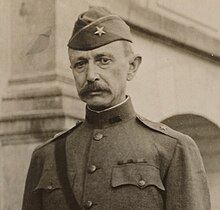John S. Winn | |
|---|---|
 Winn in France, January 1919. U.S. Army Signal Corps photo. | |
| Born | November 26, 1863 Winchester, Kentucky, U.S. |
| Died | January 24, 1940 (aged 76) Berkeley, California, U.S. |
| Buried | |
| Service | United States Army |
| Years of service | 1888–1922 |
| Rank | Brigadier General |
| Service number | 0-205[1] |
| Unit | U.S. Army Cavalry Branch |
| Commands | Troop D, 2nd Cavalry Regiment 2nd Squadron, 2nd Cavalry Regiment 7th Infantry Brigade 73rd Infantry Brigade 157th Infantry Brigade 79th Division 2nd Cavalry Regiment |
| Wars | Spanish–American War Philippine–American War United States occupation of Veracruz Pancho Villa Expedition World War I Occupation of the Rhineland |
| Awards | Silver Star Legion of Honor (Officer) (France) |
| Alma mater | United States Military Academy |
| Spouse(s) |
Grace Stanley Legrow
(m. 1890–1940) |
| Children | 4 |
| Relations | Frank L. Winn (first cousin) |
John S. Winn (November 26, 1863 – January 24, 1940), was a career officer in the United States Army. A veteran of the Spanish–American War, Philippine–American War, United States occupation of Veracruz, Pancho Villa Expedition, World War I, and the Occupation of the Rhineland, and he attained the rank of brigadier general. Winn commanded brigades in France during the First World War, and was a recipient of the Silver Star and the French Legion of Honor (Officer).
A native of Winchester, Kentucky, he graduated from the United States Military Academy at West Point in 1888 and was commissioned in the Cavalry Branch. During his early career, Winn performed frontier duty in the northwestern United States. From 1892 to 1896, he instructed mathematics as a member of the West Point faculty. He served in Cuba during the Spanish–American War, and the Philippines during the Philippine–American War.
Winn went on to serve in Mexico during the United States occupation of Veracruz and on the Texas–Mexico border during the Pancho Villa Expedition. During World War I, Winn was promoted to temporary brigadier general, and his commands included the 7th Infantry Brigade, a unit of the 4th Division, the 73rd Infantry Brigade, a unit of the 37th Division, and the 157th Infantry Brigade, a unit of the 79th Division. Winn's wartime heroism was recognized with award of the Silver Star and the French Legion of Honor (Officer).
After the war, Winn returned to his permanent rank of colonel and commanded the 2nd Cavalry Regiment until retiring in 1922. In retirement, he resided in Berkeley, California. In 1930, the U.S. Congress enacted legislation permitting First World War general officers to retire at their highest rank, and he was promoted to brigadier general on the retired list. Winn died in Berkeley on January 24, 1940, and was buried at West Point Cemetery.
- ^ Davis, Henry Blaine Jr. (1998). Generals in Khaki. Raleigh, North Carolina: Pentland Press. p. 387. ISBN 978-1-5719-7088-6 – via Google Books.